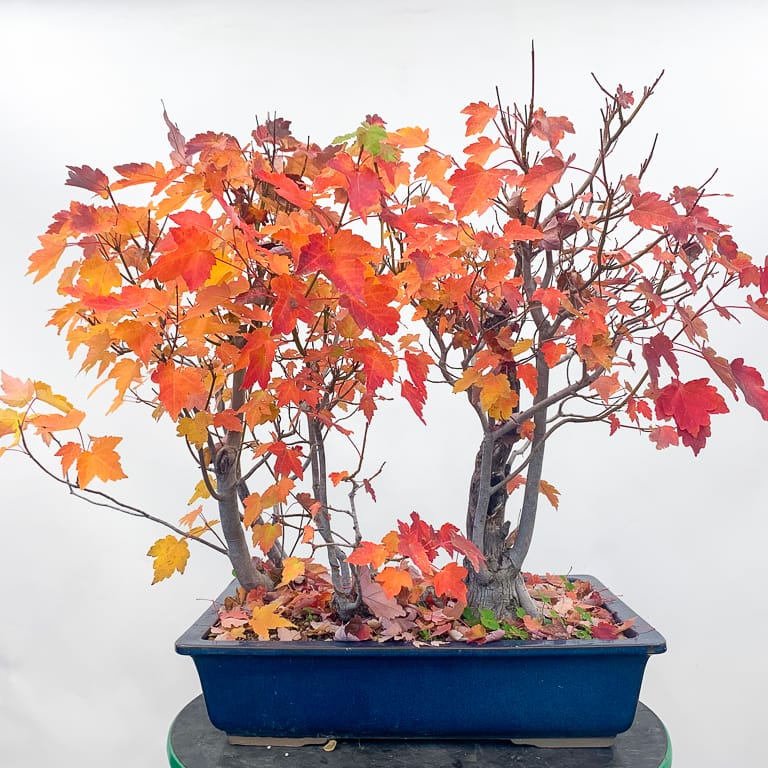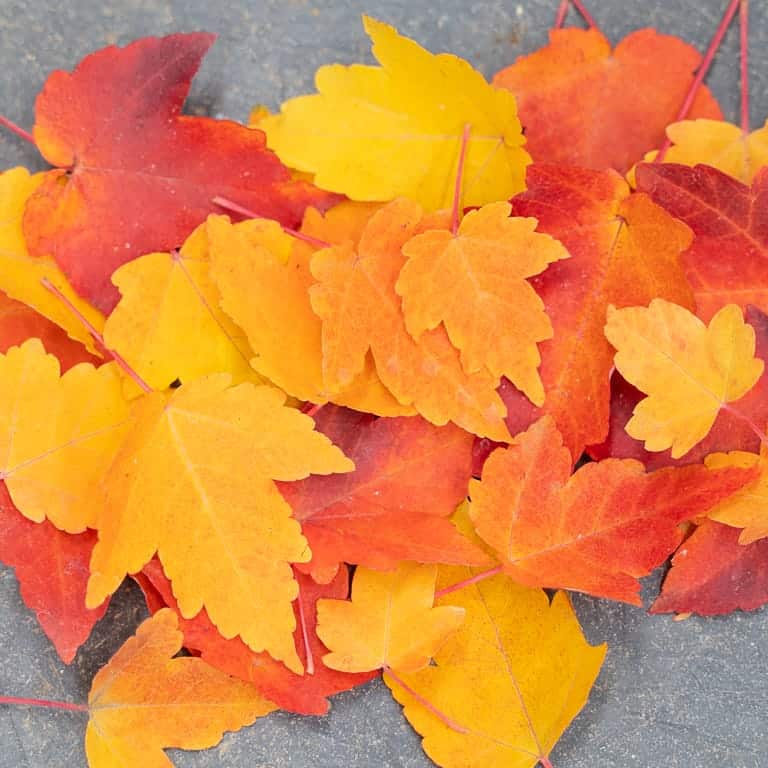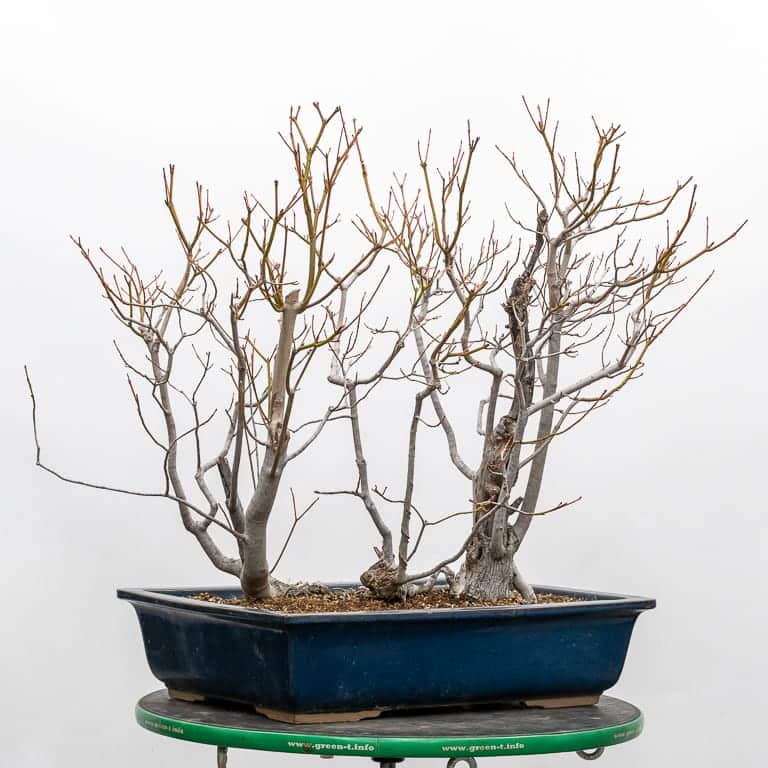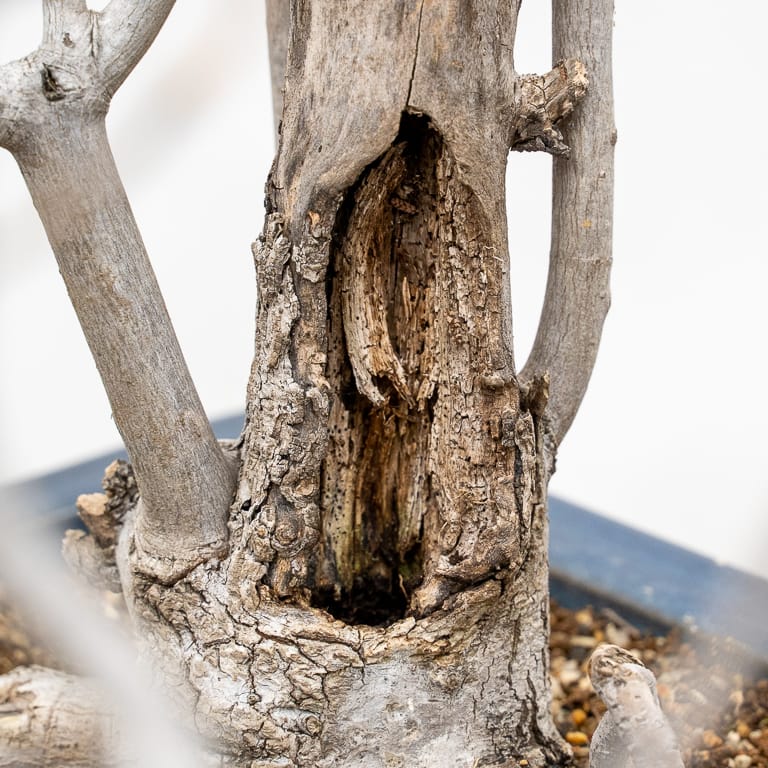I’ve only recently started caring for a red maple, Acer rubrum, but I’ve already been impressed by its charms. If you’re looking for a U.S. native deciduous species to experiment with, the red maple is a good place to start.
1. Fall color
Red maples – aka swamp maples – can produce spectacular fall color. Even in the Bay Area, a location not known for its fall color, red maples can produce bright pinks, reds, oranges, and yellows.
I didn’t get a photo of the maple below when it first changed from green to pink-red, but even the waning fall colors proved attractive.

Fall color on red maple

Red, orange, and yellow leaves
2. Fine twigs
Like many species in the maple genus, red maples are naturally vigorous growers. Despite this, a combination of pruning and defoliation can produce small leaves and fine twigs.
The tree below grew freely since a mid-summer pruning and produced a surprising number of fine twigs. I’m looking forward to learning how dense and twiggy red maple specimens can get.

Winter silhouette – 23″
3. Adaptable and widely available
Red maples are native to the eastern U.S. and range from Texas to Florida to Canada. They grow well in warm climates and cold climates and can thrive in a variety of soils and light conditions.
They can also offer opportunities for creating deadwood features. Older or collected specimens may feature dead trunks and new shoots that sprout from the lower trunk or roots.

Deadwood with new shoots sprouting from the base of the trunk
Caveats
Like most species, red maples may have qualities that don’t make them a good candidate for your bonsai collection.
While many cultivated varieties feature brilliant fall color, some are more allergenic than others. Red maples are also toxic to horses if that’s a concern.
If you’re curious to learn more, The wikipedia entry for Acer rubrum provides a good overview of the species’ good and bad points, including the tidbit that suggests the species can be used for syrup production!
Do you have red maples in your bonsai garden? If so, feel free to share your experience in the comments below.
New YouTube Video for Bonsai Empire’s 20th Anniversary
Bonsai Empire is celebrating their 20th Anniversary with videos from bonsai professionals around the world. Topics range from Bjorn Bjorholm discussing which branches to keep or cut to Peter Warren discussing soil and water pH.
I contributed a video answering the question of how to grow a bonsai from seed.
You can find a complete list of videos on the Bonsai Empire blog, or follow their YouTube channel here.
Congratulations Bonsai Empire – we’re looking forward to the next twenty years!
Subscribe to Bonsai Tonight
New Posts Delivered Every Tuesday and Friday
Richard Sintchak says
Great post Jonas! 🙂
Jonas Dupuich says
Thanks, Richard!
Jeremy says
Nice post! I have always been too scared to try my hand at red maples because their leaf size is so large, but your post is making me rethink it. How tiny can you get the leaves? Have you experimented with any specific cultivars have you experimented with?
Jonas Dupuich says
Thanks, Jeremy! I’ve only just started caring for this specimen so I don’t know what to expect from the leaves. The smallest leaves were under 1″. I haven’t tried any cultivars yet either – it looks like there are lots of them!
Francisco Del Valle says
Thanks Jonas, this post came just at the right time. I’ve been slowly getting into bonsai and I was recently looking at some red maples at my local Lowes that are on sale right now. My plan was to do an air layer this spring and see how it worked as a bonsai, and probably do a trunk chop on the remaining tree next spring.
Also, great post on the Bonsai Empire video. I was the list of topics on their webpage and was looking forward to your video.
Jonas Dupuich says
Thanks, Francisco! Let us know how the red maple project goes. Thanks about the video too!
Richard Walden JR says
Great video Jonas,
I’ve only been growing for a few years now. Found you blog a year or so ago, and read it every week. Glad to see you on YouTube. Loved it!! I watch a lot of videos on YouTube, would love be to see more from you.
Jonas Dupuich says
Thanks so much Richard! I’m trying to do more videos – it’s been fun to get started with it!
Doug Zeeff says
I love Red Maples because every year I have thousands sprouting naturally on my property here in North Carolina. Two years ago I potted up a couple dozen with the plan of making a forest with them. I wired some of the trunks to give them motion. Two of the trees grew so rapidly that I now have wire scars. The rest are fine. I am anxious for spring so I can get started on my project.
Jonas Dupuich says
Wow, that’s awesome! I’ll look forward to seeing some red maple forest plantings from your garden one of these days.
Thomas says
Michael Hagedorn has a great acer rubrum which he has done a number of blog posts on. It’s a tree he inherited from Anne Spencer who developed it over many years. I pasted a couple links to some of those posts below. They show what is possible to achieve. I’d really like to start working with this species as well— way up in the tundra of northeast WI is too cold in winter for some maple species- without a lot of protection…
https://crataegus.com/2011/10/31/leafless-red-maple/
https://crataegus.com/2011/10/18/red-maple-in-fall-color/
Jonas Dupuich says
Thanks for sharing the links – I forgot about that tree! I’ll have to ask Michael for any tips about the species.
Greg Peterson says
Interesting that this should come up as a subject! Since moving to North Carolina earlier this year, I have been keeping an eye on various natives to assess them for suitability as bonsai. This is my first fall in the region, and Acer rubrum really sticks out even in a mixed deciduous/conifer forest. Not only because of the brilliant colors, but because they appear to hold their leaves longer, and color later, than many other deciduous. I look forward to seeing your experience with leaf size and ramification development! I don’t have any Acer rubrum currently, but plan on collecting some this spring.
Jonas Dupuich says
I noticed the same thing about them holding onto their leaves longer – it’s a good way to extend the fall color in the garden! If you do give them a try, do let me know how it goes!
Greg Peterson says
Absolutely!
Jerry says
Interesting you commented about them holding on to their leaves, I was going to mention that as well. In fact I have six potted trees along the side of my office (eastern exposure). Two of the six trees are located just beyond the end of my office so they receive full sun all day long, where as the others are shaded by my office in the afternoon. Those two still have leaves on them. It was such a stark difference that I took a picture! I guess this relates to the “micro-climate” discussed on the podcast. Lesson for me to remember for future placement.
Tony says
Jonas….Thank you so much for posting the Florida Swamp Maple….especially the fall colors!….I missed them this year…..this group has always provided faithful colors of autumn!
Thanks again
Tony
Jonas Dupuich says
The color was fantastic this year – will need to get more photos next year!
Philippe St-Jacques says
I have a red maple collected at the swampy edge of a crop field in Montreal, Canada. I will layer the top of the tree and grow a new tree with the base. Up here they have larger leaves, but I have seem quite small leaves on lower branches so they can be miniaturized to some extent. There a few good red maple bonsai in the local collections.
The fall colors of Acer rubrum are splendid and can even be complex as in the picture below that I took from my tree. I also like their grey and smooth bark that gives them a delicate look.
http://philstjacques.com/botanique/automne-rouge.html
Acer rubrum self hybrids with another native species in Canada, Silver maple or Acer saccharinum and that hybrid is called Acer x freemanii. It is simply gorgeous. The city is planting a lot of Acer x freemanii as a street tree, to my pure delight. I put a fall color picture on the same link above (second picture).
Jonas Dupuich says
Hi Philippe – thanks for the note! The colors in your photos look beautiful, and I’m not surprised that the red maples can hybridize with other local maples. You’re making a good case to visit Montreal in fall!
Boris says
just got 2oz of seeds + it’s a gift when yo renew your arborday membership.
Zack Clayton, CBS Editor says
Keith Scott, a long time member of the Columbus Bonsai Society and for many years the Curator of the Phipps Conservatory in Pittsburgh and founder of their bonsai collection used to say that in his opinion, Acer rubrum was the best North American tree for Bonsai. In my experience, it survived a move from Michigan to Florida and back, adapts well to pot culture, ramifies well, has good bark and leaf color in spring, summer and fall, and tolerates temporary wet and semi-dry conditions. I have found it likes a loam heavy soil and my best mix is 2/3 Turface and 1/3 coffee grounds. As Doug Zeeff noted, they are a prolific seeder and volunteers are what got me started in Bonsai. Like most maples, they do hybridize freely so Your collecting experience may vary.
Jonas Dupuich says
Thanks so much for the info Zack – I’m optimistic that we’ll see more and more of these in coming years!
Jerry says
Great article Jonas! I’m glad you’re promoting this species. As we’ve discussed before, I’m anxious to see what you do with your forest planting. I have several of these and I will be contacting you for a video session after the holidays to get some advice on the best way to move forward with them. My trees did not get much color this year, certainly not the amazing colors you posted. This is true of my potted Acer Rubrum as well as the two large trees I have in my yard. Is there something that can be done to encourage them to produce more vibrant colors next fall?
Jonas Dupuich says
Thanks, Jerry! Fall color relies on the weather more than anything so there’s not much to do on that score, but one thing come to mind that relates to defoliation. When trees are partially defoliated the leaves are different ages in fall. If you see a pattern among the leaves that some color up and others don’t, that could be a clue about what to do differently next year.